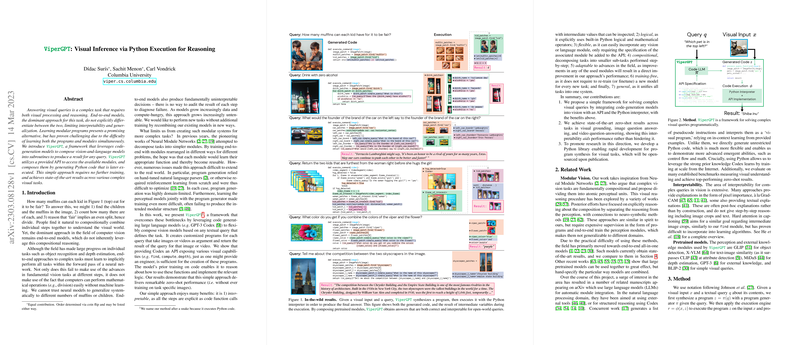Visual Inference via Python Execution for Reasoning
This paper introduces a novel framework for addressing complex visual queries, proposing a method that integrates vision, language, and reasoning through the generation and execution of Python code. The presented framework leverages the capabilities of code-generation models, particularly LLMs, to dynamically compose and execute programs that address multimodal reasoning tasks without additional task-specific training.
Overview
Traditional approaches to multimodal reasoning in visual question answering typically involve end-to-end models that handle both visual processing and reasoning within a single deep learning pipeline. While these models have demonstrated significant success in tasks such as object recognition and depth estimation, they often lack interpretability and flexibility, particularly in handling tasks that are outside the scope of their training data or require systematic compositional reasoning.
The proposed framework overcomes these limitations by adopting a hybrid approach that combines pretrained vision modules and a code-generation model (e.g., GPT-3 Codex). This combination allows for the generation of Python code that embodies the reasoning logic required to answer complex visual queries. By exposing an Application Programming Interface (API) of various visual capabilities to the code-generation model, the framework synthesizes executable code that integrates these capabilities in response to textual queries about visual inputs.
Key Contributions
- Framework Design: The framework facilitates compositional reasoning by generating a program for each query, which is then executed to derive the answer. This modular approach inherently supports interpretability, as each step in the reasoning process is explicit and inspectable within the generated code.
- State-of-the-Art Performance: The framework achieves strong zero-shot performance across multiple challenging visual tasks, including visual grounding, image question answering (QA), and video QA. This is notable given the lack of additional training on task-specific datasets, highlighting the versatility and effectiveness of the proposed approach.
- Advancements in Interpretability: By utilizing explicit programmatic reasoning, the framework enhances the interpretability of the decision-making process. Researchers can assess intermediate values and logic steps, potentially guiding further improvements or diagnosing errors in the perceptual models.
- Flexibility and Future Proofing: The framework's design is inherently adaptable, allowing for the integration of improvements in underlying model capabilities as they develop. It is generalizable across domains and tasks, enabling rapid adaptation to new challenges without requiring retraining.
- Open-Source Tools: To support the broader research community, the paper also announces the development of a Python library to facilitate the synthesis of programs for visual reasoning tasks. This tool is intended to foster further research and development in the integration of programmatic reasoning in AI.
Implications and Future Directions
The implications of this work are significant both theoretically and practically. Theoretically, this approach underscores the potential of combining cognitive science insights—such as dual-process theories—with computational advances in AI, particularly LLMs. Practically, the framework offers a path toward more efficient and interpretable AI systems that do not require exhaustive datasets for every new task or domain.
Future developments could involve expanding the range of modular functions and improving the robustness of the generated programs. This could lead to applications in dynamically changing environments where adaptability and interpretability are critical. Moreover, as LLMs and vision models continue to advance, this framework stands to benefit proportionally, further enhancing its capabilities and applicability across even more complex reasoning tasks in AI.
